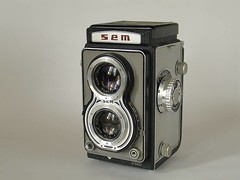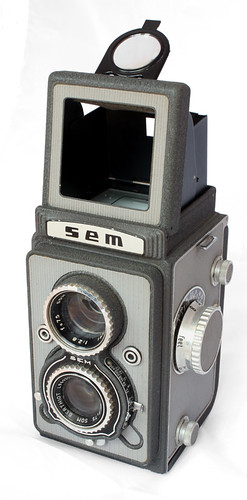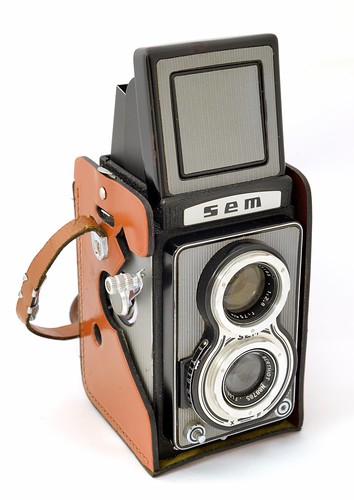Semflex

|
| Semflex Automat image by Mech for i (Image rights) |
Semflex
The Semflex is a 6x6 twin-lens reflex, launched in 1949 by the French maker SEM. At a time when products imported from Germany to France were very expensive, the Semflex was a Rolleiflex copy and competitor. It was a robust and efficient machine, whose finish was a bit rough, but whose durability was very good, as well as the image quality on most of the models.
There were many Semflex variants, with button or crank advance, coupled to the shutter winding or not. The best models had 4-element 75/3.5 Angénieux or Berthiot lenses, which were nice Tessar copies. Some of the cheaper and older ones had three-element lenses. A few were dual format, with masks for 6x4.5 frames as well as the 6x6[1].

|
| Semflex Standard 61 Type 15 with Berthiot 75/3.5 lens, knob wind and non-self-cocking shutter image by AWCam (Image rights) |
As a rule of thumb, all the f:4.5 and f:3.8 lenses are 3-element, and all the 3.5 lenses on the crank-advance models are 4 element. Some 3.5 lenses on the older button-advance models were 3-element. Sometimes the sellers want more for a model with an Angénieux lens, but it seems there is no practical quality difference with Berthiot (it is a bit like the Planar vs Xenotar or Tessar vs Xenar situation with the Rolleiflex).
The Semflex is not well known outside France but in the country it is easy to find and quite inexpensive.
Semflex Studio
The Semflex Studio is a derivative of the Semflex with a fixed Berthiot 150/5.4 tele lens. The viewing lens is a 150/3.9. There are small variations, mostly with crank-advance. The Semflex Studio, launched in 1952, predates the Tele Rolleiflex, which only appeared in 1961.
Bibliography
- SEM et les Semflex, P.-H. Pont, ed. Fotosaga
Links
|
General linksIn English:
In French:
In Japanese: Repair notes |
